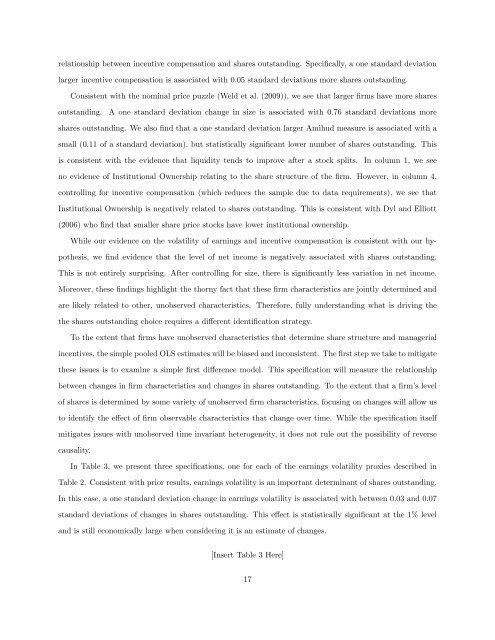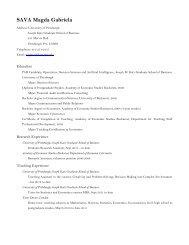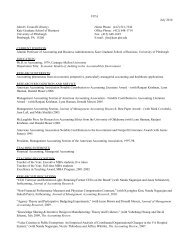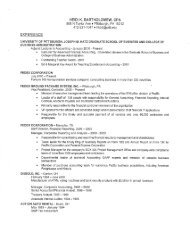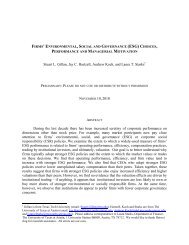Gaming the Float: How Managers Respond to EPS-based Incentives
Gaming the Float: How Managers Respond to EPS-based Incentives
Gaming the Float: How Managers Respond to EPS-based Incentives
You also want an ePaper? Increase the reach of your titles
YUMPU automatically turns print PDFs into web optimized ePapers that Google loves.
elationship between incentive compensation and shares outstanding. Specifically, a one standard deviation<br />
larger incentive compensation is associated with 0.05 standard deviations more shares outstanding.<br />
Consistent with <strong>the</strong> nominal price puzzle (Weld et al. (2009)), we see that larger firms have more shares<br />
outstanding.<br />
A one standard deviation change in size is associated with 0.76 standard deviations more<br />
shares outstanding. We also find that a one standard deviation larger Amihud measure is associated with a<br />
small (0.11 of a standard deviation), but statistically significant lower number of shares outstanding. This<br />
is consistent with <strong>the</strong> evidence that liquidity tends <strong>to</strong> improve after a s<strong>to</strong>ck splits. In column 1, we see<br />
no evidence of Institutional Ownership relating <strong>to</strong> <strong>the</strong> share structure of <strong>the</strong> firm. <strong>How</strong>ever, in column 4,<br />
controlling for incentive compensation (which reduces <strong>the</strong> sample due <strong>to</strong> data requirements), we see that<br />
Institutional Ownership is negatively related <strong>to</strong> shares outstanding. This is consistent with Dyl and Elliott<br />
(2006) who find that smaller share price s<strong>to</strong>cks have lower institutional ownership.<br />
While our evidence on <strong>the</strong> volatility of earnings and incentive compensation is consistent with our hypo<strong>the</strong>sis,<br />
we find evidence that <strong>the</strong> level of net income is negatively associated with shares outstanding.<br />
This is not entirely surprising. After controlling for size, <strong>the</strong>re is significantly less variation in net income.<br />
Moreover, <strong>the</strong>se findings highlight <strong>the</strong> thorny fact that <strong>the</strong>se firm characteristics are jointly determined and<br />
are likely related <strong>to</strong> o<strong>the</strong>r, unobserved characteristics. Therefore, fully understanding what is driving <strong>the</strong><br />
<strong>the</strong> shares outstanding choice requires a different identification strategy.<br />
To <strong>the</strong> extent that firms have unobserved characteristics that determine share structure and managerial<br />
incentives, <strong>the</strong> simple pooled OLS estimates will be biased and inconsistent. The first step we take <strong>to</strong> mitigate<br />
<strong>the</strong>se issues is <strong>to</strong> examine a simple first difference model. This specification will measure <strong>the</strong> relationship<br />
between changes in firm characteristics and changes in shares outstanding. To <strong>the</strong> extent that a firm’s level<br />
of shares is determined by some variety of unobserved firm characteristics, focusing on changes will allow us<br />
<strong>to</strong> identify <strong>the</strong> effect of firm observable characteristics that change over time. While <strong>the</strong> specification itself<br />
mitigates issues with unobserved time invariant heterogeneity, it does not rule out <strong>the</strong> possibility of reverse<br />
causality.<br />
In Table 3, we present three specifications, one for each of <strong>the</strong> earnings volatility proxies described in<br />
Table 2. Consistent with prior results, earnings volatility is an important determinant of shares outstanding.<br />
In this case, a one standard deviation change in earnings volatility is associated with between 0.03 and 0.07<br />
standard deviations of changes in shares outstanding. This effect is statistically significant at <strong>the</strong> 1% level<br />
and is still economically large when considering it is an estimate of changes.<br />
[Insert Table 3 Here]<br />
17


